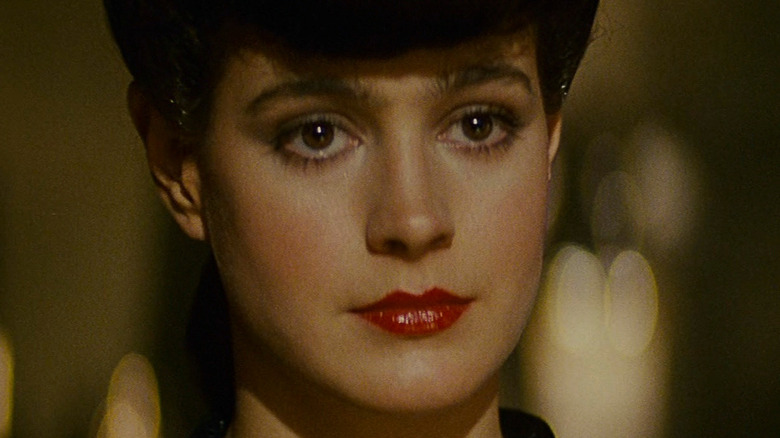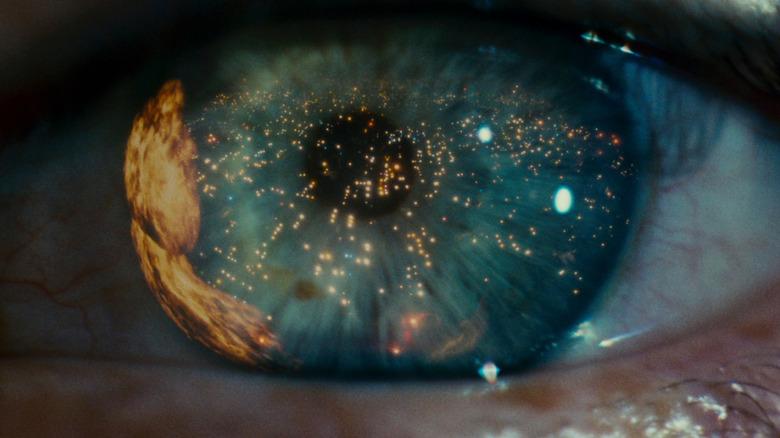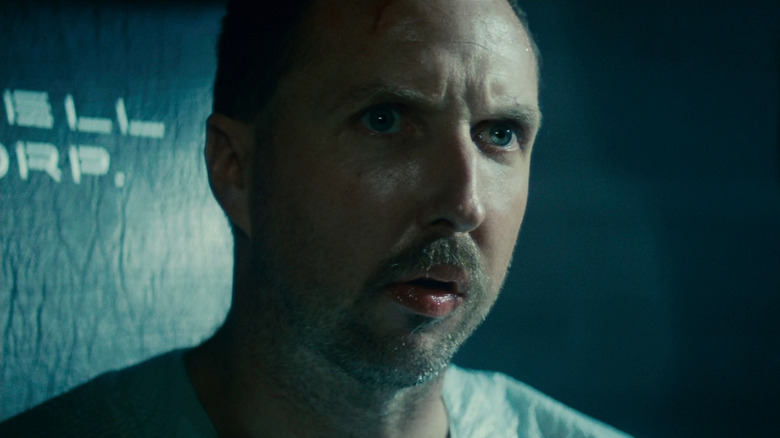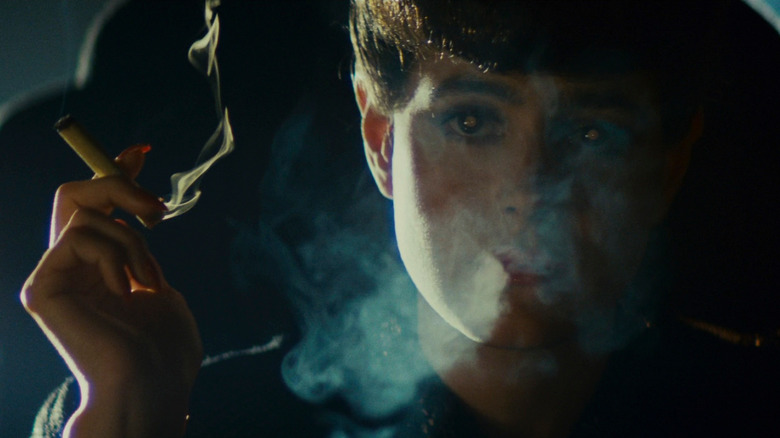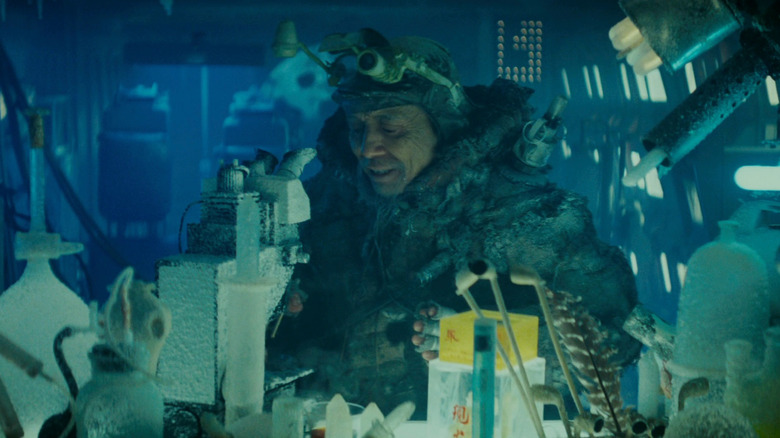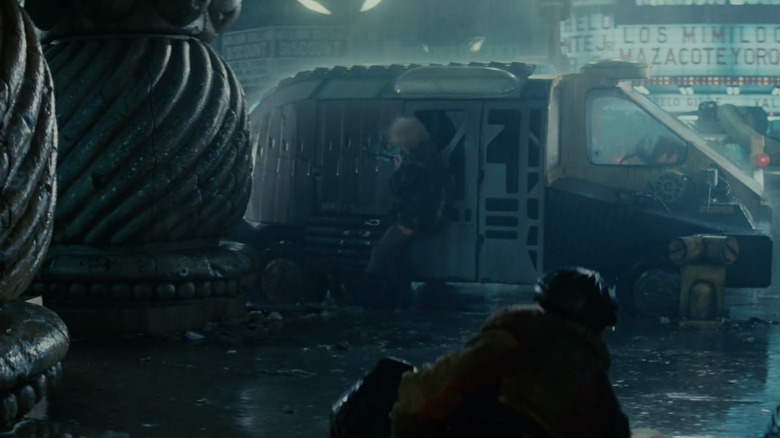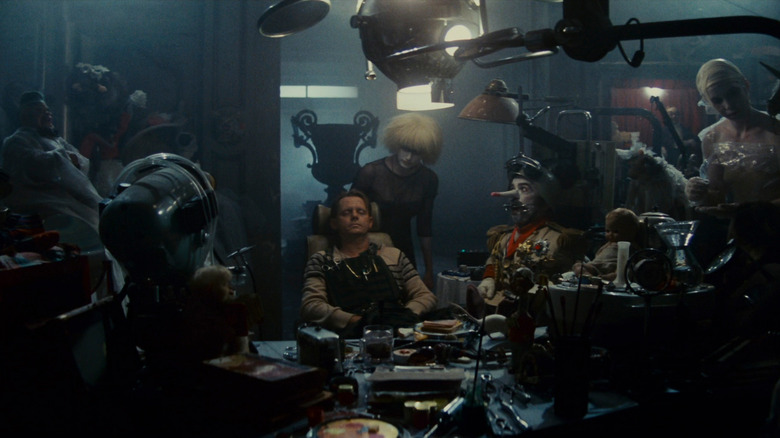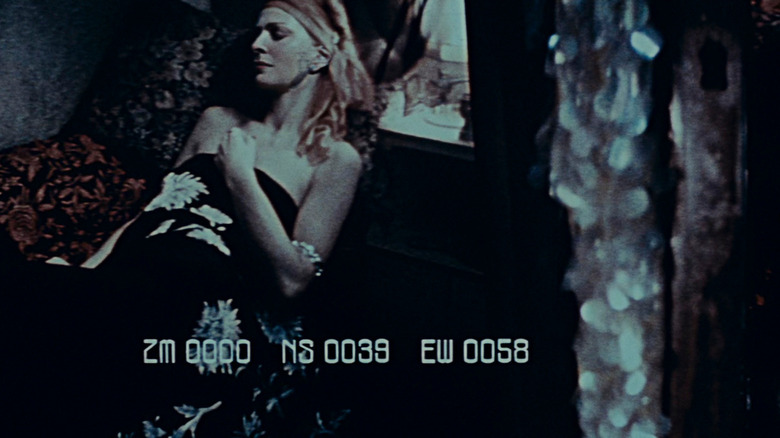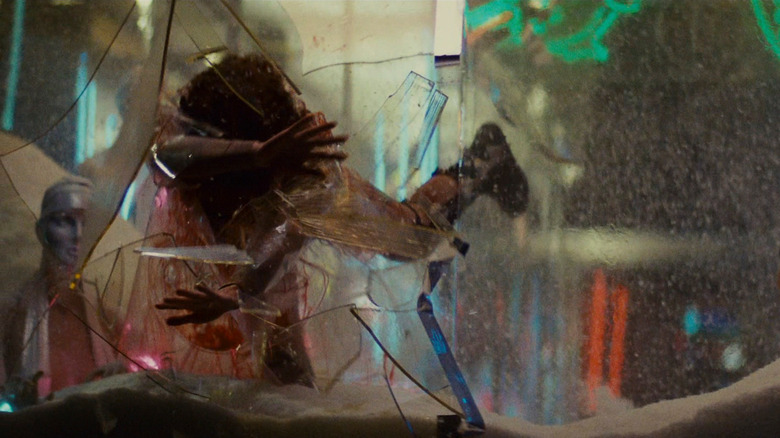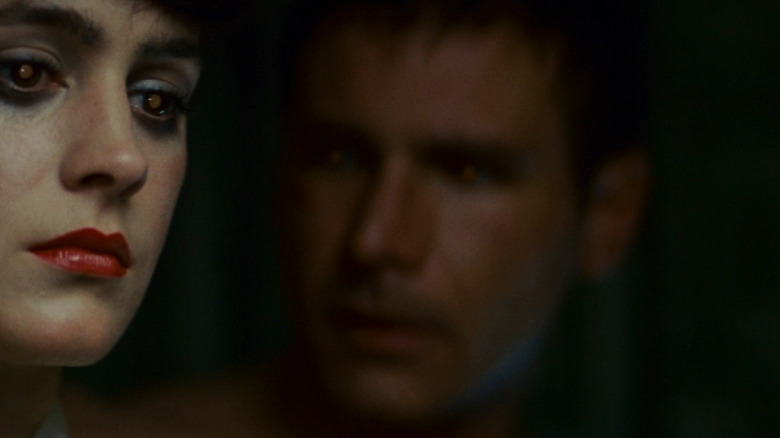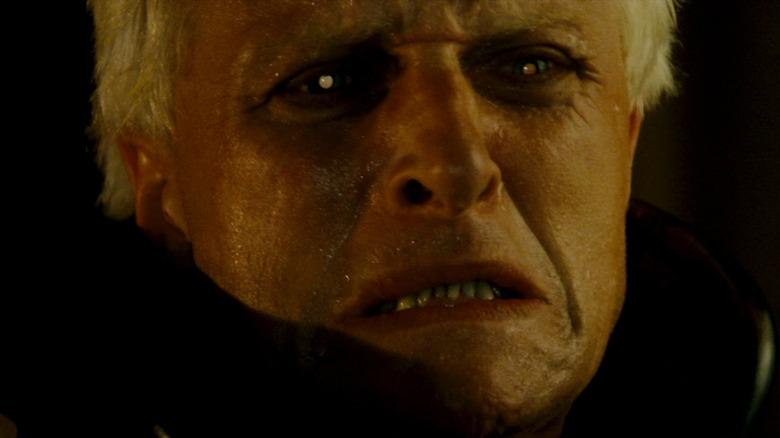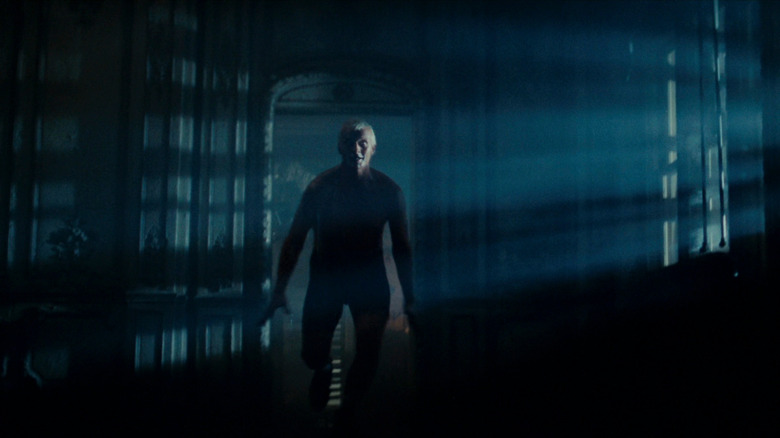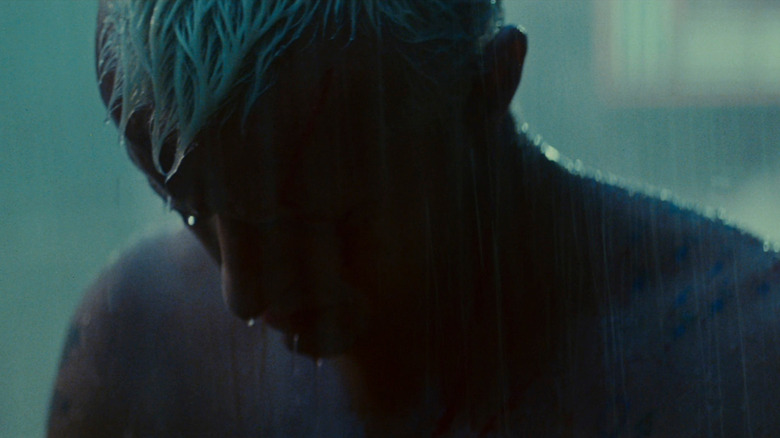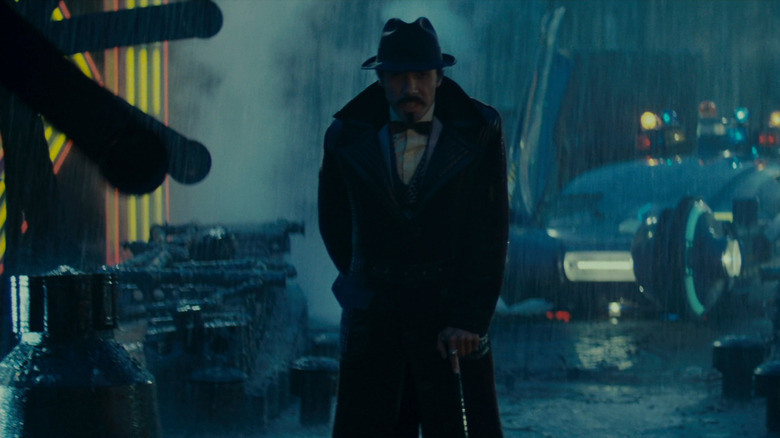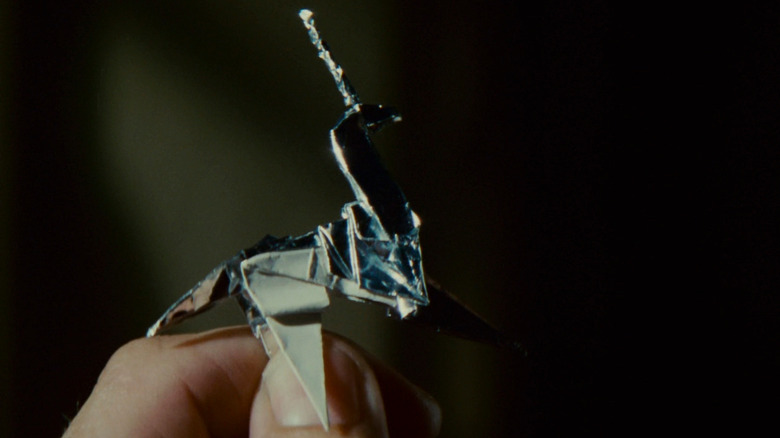The Most Pause-Worthy Scenes In Blade Runner
Directed by Ridley Scott, 1982's "Blade Runner" is one of the most influential science fiction films of all time. That might sound like hyperbole, but we've been put to a Voight-Kampff test, so you can trust us.
The film takes place in a futuristic Los Angeles where the cramped streets are a mishmash of globalization and film noir tropes. Speaking of which, our gruff hero is Rick Deckard (Harrison Ford), a blade runner who has to "retire" a small group of advanced replicants — purpose-built androids that are basically indistinguishable from real people. Pulled back in for one last job, Deckard soon finds himself wrestling with the very idea of what it means to be human (while also wrestling with killer androids who can't feel pain).
With Lawrence G. Paull's rich, tactile production design and Jordan Cronenweth's striking cinematography, "Blade Runner" is a sensory feast where every frame feels like a neon-tinged painting. You'd be forgiven for hitting the pause button to bask in the film's captivating vision of 2019. "Blade Runner" is a tour de force in show don't tell ... assuming you're watching the version of the film free from Harrison Ford's studio-mandated voice over. With all that said, let's take a look at the moments in "Blade Runner" that have us reaching for the pause button, whether it's to snag a screenshot, replay a striking moment, or contemplate the possibility that we all might actually be life-like robots with tragically short life spans. Beware spoilers below.
A fiery vision of 2019
While the introductory text of "Blade Runner" may introduce us to the concept of replicants, "retirement," and the Nexus 6 mutiny that sets our tale in motion, it's that first glimpse of the Los Angeles skyline that really tells us what kind of film we're about to see.
The year is 2019, and as Vangelis' synthetic score swells, the cityscape emerges before us — an endless sprawl of towering flames and glimmering lights, bright enough to put the night's sky to shame. Far off in the distance, barely visible through the urban haze, loom two immense ziggurats. We don't know it yet, but these anachronistic structures house the Tyrell Corporation, the company responsible for building and innovating artificial life. The towers of flame reflect in the unblinking, piercing blue eye of Roy Batty (Rutger Hauer), the Nexus 6 replicant who's returned to Earth to meet his maker.
The opening shots of "Blade Runner" ooze with atmosphere and scale. We're introduced to the film's first oracular motif and the primary tension, between man and machine, is made plain. A stupendous feat of world-building, the opening moments of "Blade Runner" belong in a museum. Wait, wrong Harrison Ford movie ... but our point stands!
Subjecting Leon to the Voight-Kampff test
With our heads still reeling from those gorgeous opening shots (and the expositive summary of mankind's complex relationship with our android creations), we're introduced to a key piece of the machinery of "Blade Runner" — the Voight-Kampff test.
In a cigarette smoke-choked interrogation room, a slack-jawed man is submitted to questioning to determine if he's really human. Sweaty and suspicious, Leon Kowalski (Brion James) enters his interrogator's cubical where a mechanical armature proceeds to focus on its subject's eye. Reaction time is a factor, he's told. And that's bad news for the slow-witted Kowalski. How is this hypothetical question about a tortoise in a desert relevant to the test? Kowalski doesn't even know what a tortoise is. These questions are designed to provoke him, and it's working. Before the second question can fully form, Kowalski's gun is smoking, and his interrogator slouches lifelessly in his office chair.
A terse and unforgettable scene that serves multiple purposes, Leon's Voight-Kampff test is a tense and tonally assured introduction to the threat posed by the Nexus 6 replicants. They are desperate, angry, and cornered — animals in a trap that will do anything to survive.
How does it not know what it is?'
Tasked with discreetly retiring what remains of the rogue replicants, Rick Deckard traipses off to the Tyrell Corporation headquarters to get a sense of what he's up against with the Nexus 6 runaways. While waiting to speak with Eldon Tyrell (Joe Turkel), Deckard meets his assistant, Rachael (Sean Young). Invoking generations of femme fatales before her, Rachael flips the script and presses Deckard on whether he's ever retired a human by mistake. Before Deckard can elaborate on the "hazards" of his line of work, Eldon enters the room and demands that Deckard "indulge" him with a negative Voight-Kampff, offering Rachael as a test subject. To Deckard's and our surprise, Rachael is revealed to be a replicant ... a fact that she herself is not aware of.
The exchange between Deckard and Rachael is one of the film's most iconic sequences. While Eldon smiles smugly in the shadows, Rachael's cigarette smoke clouds her profile as she swats Deckard's questions away one by one like flies. It's also during this scene that we're first introduced to the replicant's glowing eyes, reflective, piercing pupils that give away a being's artificiality. "How can it not know what it is?" asks Deckard, his concern barely veiled. Implanted memories, Tyrell explains — the key to controlling artificial lifeforms is they must never know what they are. It's a revelation that throws everything into question. Who can you trust when you can't even trust your own memories?
A visit to the eye doctor
In our first true scene with the steely Roy Batty, the Nexus 6 replicants pay a visit to the eye doctor. In this memorable moment, the replicants interrogate Hannibal Chew (James Hong), the man who designs artificial eyes for the Tyrell Corporation. Looking more like an Arctic explorer than a scientist, Chew is outfitted in a bulky fur coat, his scraggy beard tinged with frost. He quickly notices that his intruders appear unaffected by the harsh chilly conditions of his lab, a dead giveaway of their replicant status.
"Yes. Questions?" Batty replies icily to Chew's horrified gaze. "I just do eyes," he pleads. "I designed your eyes," he continues, unable to contain a glimmer of self-satisfaction in his quivering voice. "Chew, if only you could see what I've seen with your eyes," responds Batty. While Chew shivers and pleads for his life, he offers up a name: J.F. Sebastian, the man who can get the rogue replicants to Tyrell.
It's always a pleasure to see James Hong on screen (the man has over 450 credits, so pleasure abounds), and the veteran character actor does a fantastic job at conveying the pride and sorrow innate in this "Frankenstein"-like tale. He pities and fears the replicants. Rightfully so, it turns out. Additionally, the scene serves the purpose of breaking up the dour, neon-lit metropolis with a noticeably different setting. Why must Chew's eyeball lab be freezing? Maybe because it looks cool, get it?
Daryl Hannah breaking her elbow for real
While Pris (Daryl Hannah) might seem out of place alongside her fellow replicants, her introduction proves that a pleasure model is as tenacious and resourceful as any military-grade Nexus 6. Slinking through the streets, constantly checking over her shoulder, Pris settles down in a heap of trash, only to be "surprised" by a man we later learn is J.F. Sebastian (William Sanderson). Startled, or so it seems, Pris takes off running, smashing into Sebastian's van. Once things settle down, Pris does what she does best — charming her new acquaintance with an open smile.
While Hannah's duplicitous veneer is certainly "pause-worthy," what's really going to have you reaching for the rewind button is a lot less glamorous. As detailed in the 2007 documentary "Dangerous Days: The Making of Blade Runner," Pris smashing through the window of Sebastian's car was a total accident. If you look closely, you can see Hannah slip on the wet ground and careen through a sheet of real glass. The impact caused Hannah to chip her elbow in eight places. And while the on-set injury was no doubt painful, Hannah pressed on with the scene, barreling through without breaking character. Are we sure that Daryl Hannah isn't a replicant?
They're my friends
When J.F. Sebastian brings Pris up to his apartment, he informs the fawning android that he lives "pretty much alone," which is kind of burying the lede. In the next breath, he clarifies that he's good at "making friends," failing to mention he means that quite literally. See, where Tyrell builds androids, Sebastian builds toys. "It's my hobby, I'm a genetic designer," Sebastian continues, as if that makes things anything less creepy.
Alarmingly spacious and antiquated, Sebastian's apartment is a relic of a bygone era — a rotting architectural carcass full of cast-out mechanical prototypes. In truth, Pris doesn't feel all that out of place in this island of misfit toys. Sebastian is an oddity himself, prone to accelerated aging that makes him appear wizened beyond his years. There's so much detail in Sebastian's apartment that it can be tempting to freeze the frame and pick away at the set dressings. And luckily for those of us who like that kind of maximalism, there are plenty of opportunities to hit pause, as Sebastian's spacious apartment proves the perfect arena for the climactic finale.
Computer ... enhance
We've all grown accustomed to the idea of some sort of super-powered technology that zooms in on photo evidence, as it's pretty cliché for cops in procedurals to command their I.T. guy to "enhance" an indecipherable picture. But even if you're familiar with the "zoom ... stop" song and dance, Deckard's use of the tech will still have you leaning in.
Once you've recovered from the shock of seeing Deckard scan a physical photograph into a computer, you must contend with how impossibly crisp and detailed said photo really is. From the comfort of his apartment floor, Deckard commands the machine's attention throughout the frame until he notices a mirror in the back ... and then proceeds to zoom into the reflected image. In that reflected image, he finds exactly what he's been looking for — a reclined woman, the assumed owner of the suspicious scale found at Leon's apartment.
Seeing as our only glimpse of Zhora (Joanna Cassidy) here is just that — a short and sweet glimpse — recognizing the significance of Deckard's discovery may take a second to process. Luckily, while our "zoom ... stop" tech might not be quite up to Deckard's snuff, we do have pause buttons.
Retiring Zhora
It's not clear when Zhora clues into the fact that Deckard was a Blade Runner, but when her elbow makes contact with his gut, she seems to get the overall picture — this dude means her harm. And now, Zhora has two options ahead of her: fight or flight. While her attempts to strangle Deckard initially look promising, the intrusion of other dancers at the club pushes Zhora into plan B.
What follows is a blood-pumping chase scene through the soaking wet streets of futuristic Los Angeles. As the film's soundtrack fades into the background, the chaos of the street lurches forward, heightening Deckard's panic as he scans his surroundings for the runaway replicant. The cat-and-mouse chase continues as Zhora attempts to lose herself in the crowd.
But when Deckard draws his gun, Zhora stops being stealthy. She sprints across car hoods. Deckard shoots and misses. And then, as Vangelis' score steadily creeps back, Zhora plummets through multiple sheets of glass in a storefront. Playing out in slow-motion, Zhora's death feels downright melancholic. If these replicants are so evil, why does Zhora's death feel so sad? In addition to being a gripping action sequence, this is also our first hint that there might be something deeper going on with the replicant rebellion.
Deckard's glowing eyes
After Rachael saves Deckard's life by shooting Leon, the two return to the blade runner's apartment. While Deckard nurses his wounds (read: dunks his head in a sink), Rachael contemplates her immediate future. Should she flee north? If she did, would Deckard hunt her? During their conversation, Rachael's eyes glow with the characteristic tell that she's an android. But what's this? In one shot, it sure looks like Deckard's eyes are glowing too. This would surely lend credence to the theory that Rick Deckard is also a replicant, right?
Well, long story short: It's complicated. If you pause the moment in question, you'll see that you're not imagining things. Deckard's pupils are glowing. As to why they are glowing, the real answer is less exciting than the famed android conspiracy. As laid out in the July 1982 issue of American Cinematographer, the glowing eye effect was achieved live on set by reflecting warm light through a special mirror into the actors' eyes. And it's likely that the light being beamed into Sean Young's eyes was also picked up by Harrison Ford's peepers. But, if you want to think of Deckard's glowing eyes as more than an accident, screenwriter Hampton Fancher has you covered. He's on record that he wrote Deckard as human, but he's down to keep things ambiguous. Meanwhile, Ford and Ridley Scott reportedly still disagree on the matter to this day.
The prodigal son returns
Under the pretense of a late-night chess match, J.F. Sebastian innocently shepherds Roy Batty into Tyrell's apartment. Immediately wise to the nature of the visit, a Shakespearean tete-a-tete ensues. "Can the maker repair what he makes?" Roy asks, venom and pleading couched in every word. Roy wants to be a real boy. He wants more life — an extension on the artificial stopgap implemented to curb any uppity replicant that wants more out of life. The confrontation is electric, full of tension so thick you could cut it with a knife.
There are always religious intonations when creations meet their maker. The shadow of Mary Shelley's "Frankenstein" looms large too. "You were made as well as we could make you," Tyrell soothes. "But not to last," Roy adds. For a brief moment, the scene turns tender. Tyrell runs his hand over Roy's brow and through his hair. Like a guilty child, Roy confesses that he has done "questionable" things (a cute way to describe multiple homicides). Then, a dark turn tips the scene into iconic status: Roy bestows a kiss of death. Then, as cracking bones fill our ears, it becomes clear that Roy intends to murder his "father" with his own bare hands. And with all hope of extending his time in this universe gone, Roy begins his descent into madness.
Deckard vs. Roy
Unfortunately for Roy, his reckless murder of Tyrell has brought down the fuzz. Deckard is the first on the scene at J.F. Sebastian's apartment. There, a vicious and brutal showdown ensues between Deckard and the surviving rogue replicants. After a fast and furious gymnastic tussle with Pris in which the dolled-up pleasure bot is violently retired, Deckard comes face to face with Roy.
Already having killed his "father" and made peace with his inevitable demise, Roy is like a bull in a china shop. Roy starts things off by grabbing Deckard's hand through a wall and breaking the blade runner's fingers one by one. And then the game begins. Roy gives Deckard a running start, filling the apartment's soggy halls with his mournful howls. Few things are more dangerous than a wounded animal, especially when said wounded animal is a genetically engineered super soldier that can't feel pain. Indeed, the chase feels more aligned with the horror genre than with science fiction — two hurting, desperate men forced against their better selves to duke it out to the death.
Tears in rain
In a film full of incredible moments, none come close to Roy Batty's final monologue — a fact that's all the more impressive when you consider that Rutger Hauer improvised parts of it.
Just when it looks like Deckard is about to plummet to his death (it's hard to hold onto a rain-slick building when your fingers are all busted), Roy catches his would-be enemy and saves his life. Exhausted and on the precipice of his artificially mandated death, all the fight has gone out of Roy. In his final moments, he has no hatred for humanity, only awe for the short life he's lived and a melancholic desire that he could've seen more of what the universe has to offer. In his last breaths, Roy muses that all his memories will die with him. Life and the things that make it worth living are transitory and fleeting: "Lost in time ... like tears in the rain."
It's too bad she won't live
While we're still reeling from the emotional gut punch of Roy's death monologue, the enigmatic police officer Gaff (Edward James Olmos) emerges from the steamy shadows to deliver the killing blow. Thematically speaking, of course. In an exchange that takes place in the moments after Roy's demise, Gaff gives Deckard a final assignment and an existential conundrum. Deckard was already looking for a way out of the blade runner business before this assignment. And now, wet and bloodied, he's done for good. Almost.
Gaff tosses Deckard a gun, a physical reminder that one replicant is still at large: Rachael. The job isn't finished yet. But before we can contemplate what that means for Rachael and Deckard's budding relationship, Gaff turns around. "It's too bad she won't live," he calls out over his shoulder. "But then again, who does?" While there's a chance that Gaff is merely mocking Deckard, his ambiguous presence in the film endows this line with a crunchier interpretation. After all, Gaff has just summarized, succinctly, one of the film's main themes. Life is short — for humans and replicants alike. Make it count. Don't be a slave.
Do androids dream of origami unicorns?
After Rachael's first visit to Deckard's apartment, the melancholic blade runner sits at his piano in a half-drunk daze plinking away at the keys. As his gaze drifts into space, he begins to day dream. Or at least, we have to assume he's day dreaming as we share his vision of a bone-white unicorn galloping through a foggy forest.
At the end of the film, Deckard shepherds Rachael out of his apartment instead of retiring her. When he steps outside, he finds an aluminum origami unicorn on the floor. It's the work of Gaff. On the one hand, the calling card could be no more than that — a physical reminder that the cops have Deckard's number, and his betrayal has not gone unnoticed. On the other hand, the synchronicity between Deckard's dream unicorn and Gaff's origami gift feels uncanny and ominous. Is Gaff pushing Deckard to flee? Does his knowledge of Deckard's dream mean that Deckard is a replicant with implanted memories, just like Rachael? Ultimately, the real meaning behind Deckard's unicorns is left up to our interpretation. (But did anyone else spot the unicorn in J.F. Sebastian's apartment? Surely that can't be a coincidence).
